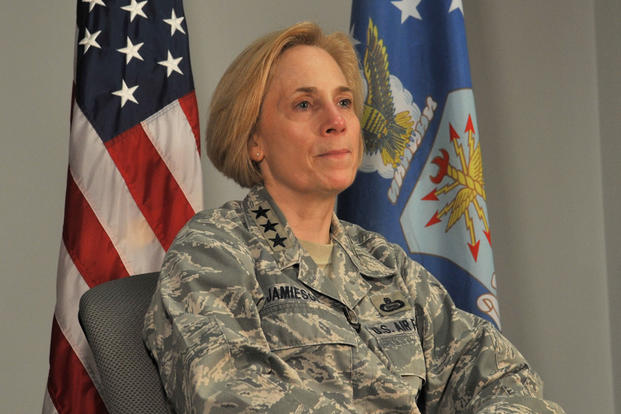China's massive investment in artificial intelligence technologies may soon leave the U.S. at a major disadvantage, a top Air Force general said Thursday.
"Speed is of the essence in the digital age," said Lt. Gen. VeraLinn "Dash" Jamieson, deputy chief of staff for intelligence, surveillance and reconnaissance on the Air Staff at the Pentagon.
She painted a grim picture: While "great instigator" Russia has the desire to do ambitious experiments with A.I., China already has the means.
For example, China is building several digital artificial intelligence cities in a military-civilian partnership to understand how A.I. will be propagated as it strives to become the global leader in technology. The cities track human movement through artificial facial recognition software, watching citizens' every move as they go about their day.
"We estimate the total spending on artificial intelligence systems in China in 2017 was $12 billion. We also estimate that it will grow to at least $70 billion by 2020," Jamieson said during an Air Force Association breakfast Thursday.
Related content:
- In Tech, US Must Be Where Russia, China Are Not: Air Force Scientist
- With Google Out of Maven, DoD Still Wants AI to Sort Surveillance Data
- Pentagon Aims to Win Global Race for New Hypersonic Technologies
"Go compare what we're spending to what China is spending," she added.
The Pentagon -- with each military service pursuing AI to varying degrees -- is still spending hundreds of millions on the effort.
According to independent research group Govini, the Pentagon spent roughly $7.4 billion on emerging technologies in fiscal 2017. While A.I. accounted for roughly 33 percent of that total, the spending also includes quantum computing and big data analysis, as well as other information technology.
Because the Air Force has been heavily entrenched in the counterterrorism effort for the past two decades, "We did not look across the entire spectrum to build and think and develop a high-end fight that we believe we are facing today," Jamieson said. "Our [intelligence, surveillance and reconnaissance] enterprise today is not postured to meet these challenges with the intent laid out in the National Defense Strategy."
Jamieson is pushing the Air Force to think differently about how it should use autonomy while keeping the human in the loop. For example, the service is shifting from discussing a single, advanced weapon to discussing more broadly how emerging technologies must network going forward.
Reiterating similar comments she made last year, Jamieson said the goal is to use A.I. to sift through millions of intelligence and sensor-gathered data points -- visual, audible, etc. -- to give airmen the answers they need to make real-time decisions that will aid those in a physical or virtual battlespace.
"We do need our analysts to harmonize the data to decision quality at speed," she said, adding "We must build the next-generation ISR enterprise capable of possessing decision advantage across the entire spectrum of conflict."
Jamieson pushed a culture change the Air Force has been grappling with for some time: transition from a manpower-intensive approach to one that leverages machine learning and artificial intelligence. That journey will begin with data, to analytics to machine intel, to human and machine teaming, she said.
"Industry and airmen will be asked to increase the quality and quantity of ISR production while remaining competent across the range of military operations. We are going to do this as a team," she said.
Jamieson said the services must not look at large data gathering only as a source of information. "Data is a weapon, and all of us need to treat data in this light."
For that reason, airmen and future generations of aimen need "to be unleashed," she added.
Airmen today understand the true blending of the physical and virtual worlds that will be needed to sustain the next fight against either Russia or China, she said.
Jamieson said in recent months she has met airmen who've been able to streamline data collection between various platforms through coding techniques.
"Airmen at the 480th ISR Wing realize the software they were using in their favorite video game -- it allowed for coordination between approximately 55 users from another game in real time in order to complete an assignment -- could be used for training in the unit," she said.
The airmen built a low-cost military version called Sentinel Sim -- something that would have cost millions if the Air Force had created it or contracted it out, Jamieson said.
Today, the game is used for live-mission training scenarios.
Between airmen, industry and the Pentagon as a whole, "This is now a team sport," Jamieson said. "And we have to look at it that way."
-- Oriana Pawlyk can be reached at oriana.pawlyk@military.com. Follow her on Twitter at @Oriana0214.










